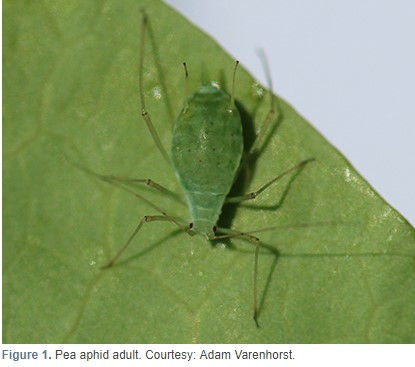By Adam J. Varenhorst
The first cutting of alfalfa is either done or underway in South Dakota, and we are starting to notice pea aphids in the fields. Although pea aphid populations can vary quite a bit from field to field it is important to monitor their populations to ensure that loss due to their feeding doesn’t occur.
Last year, we received several reports of pyrethroid insecticides not working as well as expected for pea aphid management. If pea aphids do reach populations that require management it is important to re-scout the field after 24 hours to monitor the insecticide knockdown. If populations persist after a pyrethroid insecticide application for pea aphids please contact Adam Varenhorst.
Pest Profile
Pea aphids are approximately ¼ of an inch long and are noticeably larger than other aphids that may also be observed in alfalfa (Figure 1). Both the nymphs and adults of pea aphids are light green to yellow in color. Occasionally, pea aphids can also be a pale pink color. Pea aphids have long cornicles or tailpipes that are noticeably darker at the tips. They also have characteristic dark bands on their long light-colored antennae. Although pea aphids can be present on alfalfa throughout the season, they have reduced population growth when temperatures exceed 90°F.

Scouting and Management Guidelines
When scouting for pea aphids, their presence and abundance can be quickly confirmed and determined by using a sweep net. They can also be counted on individual stems. However, this method takes much more time. Pea aphid populations tend to be greatest on the alfalfa stems and the newest growth. When large populations are present in a field the alfalfa may begin to turn yellow. Large pea aphid populations can reduce plant growth due to nutrient loss.
To scout for pea aphids, walk in a W or Z pattern with either a sweep net or examining individual plants. For the sweep net, collect 30 pendulum swings while briskly walking forward. At the end of the pattern, examine the contents of the net and count the number of pea aphids that are present. If using the direct stem scouting method, a total of 30 stems should be collected from the different legs of the pattern being walked. Each stem should be carefully cut near the surface of the soil, and then shaken into a white bucket. Once the insects from thirty stems have been shaken into the bucket, count the number of pea aphids that are present.
Click here to see more...